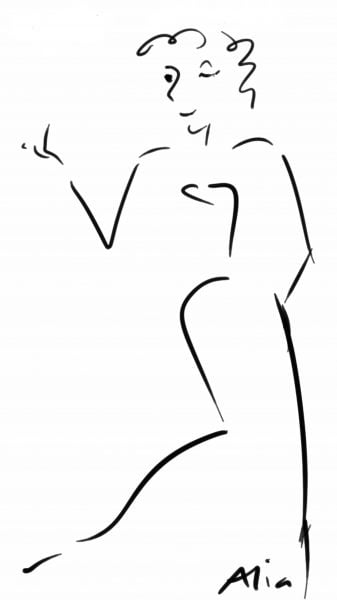Prep is kinda routine—and if you plan to video often, you will want to stramline your workflow as much as possible. My room is set up to make it easy, with lights left in position, all the connections ready. I plop my laptop down, connect a bunch of cables, position the webcam, and good to go (I used a Logitech C920 for years, now I use a Brio).
The actual dancing, once you get the hang of it, is fun—flirty, playful fun. Or over the top drama queen. Or whatever character suits the song you have in mind. That’s the easy part–after you figure out how to look the camera in the eye, to project your energy through the lens, so the people know you are looking at them, connected to them, and sending love to them (this is what How to Dance (or Speak!) for the Camera is all about).
Watching the video? For many of us, that is hell. So let’s see what we can do to reframe this.

Say Hello to VideoPal
Once the video is made, that person on the video is no longer you. Just as when you write an article or paint a painting—YOU did the creative work, but now it is outside of you; like a new baby, the umbilical cord has been cut. The new baby has its own personality, and so does Video Dancer-aka VideoPal.
This is a gender-neutral name, so we can use it for any dancer (we have the entire gender spectrum in our dance world). My pronouns are she/her; I began thinking of “her” as Video Girl. You can call your Video Pal whatever you like, as long as it is compassionate and kind. Why? Because you are now VideoPal’s proud parent/mentor. It is now your job to love and care for them.
So far so good?
NOT you.
VideoPal.
Whom you love dearly and have their best interests at heart, always.
The Cultural Dance is Our Friend
Within the culture, it is understood that the guests have a stake in the success of the evening’s entertainment. They call out and exclaim over particularly juicy bits—Allah! (Allah simply means god in arabic. My fam is christian, and we also say Allah. In English we might say, Oh my god!).
So it is for a dancer. As guests, we are responsible for extending warm and encouraging energy for the dancer, to make a good experience all around. (This is also what we do as the guests in D4C–we cheer and encourage our classmates.)
How does this relate to VideoPal?
When you watch VideoPal’s video, you want to be an Arabic audience, loving and encouraging her. This is not about how she looks—it’s about enjoying–and contributing to–the feeling in the moment.
Look for the Good
This is the very first thing. What is VideoPal doing right? What do you like? What works? Is there a cute little twinkle? A smooth transition? Great! Well done, VideoPal! Keep track and find all the good, the cute, the fun. Blandly ignore everything else. As with Rhythmic Breath we attend only to the exhale, in video review we attend only to the good.
This is vital.
We constantly look for the bad and then feel bad about it. This is literally poison to the system. The antidote is to put our focus on the good.
Applaud VideoPal and give them lots of love and support. You are their personal cheerleader. They got up there and danced! That is worth celebrating. Be happy with and for VideoPal!
Here’s some music for that ; )
A full hour of Baligh Hamdi
This is the main element for Survive. Later on, we will look at Thrive!
How to Dance (or Speak) for the Camera focuses upon all these things.
In D4C, we are each other’s Video Pal. That’s a nice feeling. And we practice, hands on. How to connect through the lens. How to be a good audience member. How to survive seeing your own work and find the good. Our bi-weekly sessions bring participants through a carefully-curated series of steps designed to bring ease and friendliness to camera work and video viewing. We do this in small groups to create camaraderie and ease. In addition to our group sessions, you get two private sessions built in to the course.
You might be wondering about those private sessions…
Private lessons, coaching, etc. are incredibly helpful, as they address your specific goals, not the other dozen or fifty people in a dance class, all trying to learn some choreography. These are your sessions, to use for whatever you want. Tech, troubleshooting, skills development; resolving fear, freeze, or anger; all and sundry are options. Making eye contact, being present and engaged without making eye contact, whatever your personal goals in online engagement, we address them in the personal sessions. Working together, we find your best way to reach your goals.
Somatic Experiencing® (SE) is one of the tools we can bring to your sessions–and it is probably is the most mysterious. What does it do? How does it work? Do I have to tell my story?
SE helps “stuck” nervous systems come back into regulation. This seems small, but it’s pretty big. Bad things happen, sometimes just once, sometimes for years. When we are unable to defend ourselves for whatever reason, our self-defensive impulses remain unexpressed–they get stuck in the body. Then we get into these recurring loops of emotion and activation because these hair-trigger alarm bells go off at the slightest provocation–even thinking about something can be activating. SE turns their switch back to As Needed, so the nervous system can go back to its normal operation–on for threat, off when the threat is resolved. If fear, anger, or freeze have been issues for you, SE can help.
SE is NOT talk therapy. It is body awareness and understanding. A brief overview of whatever you want to address is enough.
SE sessions include discovering and celebrating whatever is working in your life, what is going well. We humans tend to gloss over the good and focus on the problems; in SE we like to give the body time to to acknowledge and enjoy the good. When we address problems, we stay on the edge of them–just the tiniest mini-drop of energy is plenty. Together, client and practitioner track the physical sensations, images, and thoughts that arise in connection to the challenging situations. We allow them to complete, and allow time for that completion to integrate. If the camera, being seen (aka judged), performing, or whatever fills you with you with rage or dread, Somatic Experiencing® (SE) can help resolve that (gently). It’s just one option out of many.
What you’ll learn with D4C!
- Connect through the lens
- Bring your joy to your guests
- Be a supportive audience member
- Survive seeing your own work
- Find and celebrate the good
- Practice your live delivery with trusted friends
- Create a promo video you can use right away!
Our groups are fun, with good people, and a good vibe. We focus on positive feedback for joy, connection, and the fastest results.
One of the best things I got from this class was how to love the camera. Prior to this class, I was so afraid of the camera, the video, the equipment, etc… I found it all so totally intimidating, however, with Alia’s guidance, I was able to see through the “equipment” and find my loving fans/audience was just beyond that lens.
The class was extremely supportive and we helped each other navigate being in front of the camera in role-playing situations. By the end of the course, I was able to dance for my adoring fans (the camera…lol) with much more ease, eye contact, and confidence. This class is really for anyone who wants to dance or even talk in front of a camera. Alia shares all kinds of secrets in this class that I truly benefited from. You will be amazed at what you will learn!
–Carrie Robinson, Florida
I invite you to join us!
How to Dance (or speak) for the Camera starts next week. Registration is open through Monday, March 8. Only a few spots left!
With love,
Alia






No comment yet, add your voice below!